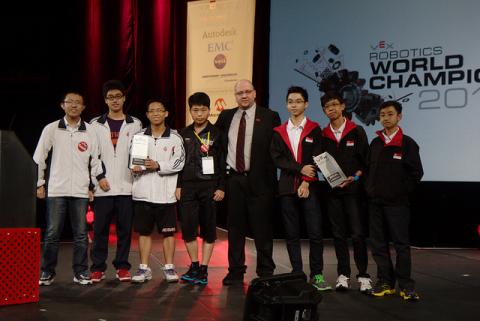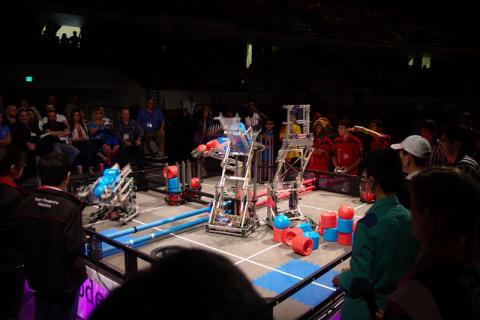Abstract:
This appendix provides information for teams who wish to compete in the VEX Robotics Competition (VRC) in an effort to qualify and compete at the VRC World Championship.
Introduction:
 In the VEX Robotics Competition, students will aim to build the most innovative robots possible and will work together to obtain the most points possible. They will do all this with guidance from their teachers and mentors. In addition to just having a great time and building amazing robots, through their participation in the VEX Robotics Competition and their work within their team students will learn many academic and life skills. The skills and lessons taught in this curriculum tie directly to the VEX Robotics Competition; students who study this curriculum are well prepared to compete in the VRC.
In the VEX Robotics Competition, students will aim to build the most innovative robots possible and will work together to obtain the most points possible. They will do all this with guidance from their teachers and mentors. In addition to just having a great time and building amazing robots, through their participation in the VEX Robotics Competition and their work within their team students will learn many academic and life skills. The skills and lessons taught in this curriculum tie directly to the VEX Robotics Competition; students who study this curriculum are well prepared to compete in the VRC.
In 2012, there were over 4800 VRC teams from 24 countries worldwide. Each year a new game is released in April; students design and build robots throughout the year, competing at local events. The top teams qualify for a chance to compete at the VRC World Championship which takes place in the subsequent April, one year after the initial release of the game. Over 500 teams compete at the World Championship, vying for the title of “World Champion.”
Getting Started as a VRC Team
As of the 2012-13 season, the registration fee to sign up a team is only $75. Even better, schools get a $50 discount on any additional teams they want to sign up, reducing the fee to only $25 for all additional teams from the same school. Teams can find more information and can register at RobotEvents.com. Local VRC events are being held in many different cities, states and countries. A full listing of events in your area can also be found at RobotEvents.com. Events are held worldwide and are being added every week to RobotEvents.com. Check back to see if new events have been announced in your area.
The Game
Each season’s VRC game is a complex challenge for teams to design and build a robot for. The game for the 2012-13 season is VEX Sack Attack. VEX Sack Attack is played on a 12’x12’ square field. Two alliances – one “red” and one “blue” – composed of two teams each, compete in matches consisting of a fifteen second autonomous period followed by one minute and forty-five seconds of driver- controlled play. The object of the game is to attain a higher score than the opposing Alliance by Scoring Sacks and Bonus Sacks in your colored Floor Goals, Troughs and High Goal, and by having the most Robots of your color Parked at the end of the Match.
There are a total of ninety-eight (98) Sacks and four (4) Bonus Sacks available as Scoring Objects in the game. Most Scoring Objects begin in designated locations on the field, while some are available to be loaded prior or during the Match. Each Robot (smaller than 18”x18”x18” to start) begins a match on one of their Alliance Starting Tiles. There are ten (10) scoring areas, five (5) of each color, of varying heights which teams can Score Sacks or Bonus Sacks in. Alliances earn a bonus for having the most Robots of their own color touching their Alliance Starting Tiles at the end of the Match. A bonus is awarded to the Alliance that has the most total points at the end of the Autonomous Period.
For more information on VEX Sack Attack please visit: https://www.vexforum.com/wiki/index.php/Sack_Attack
There are two major differences between typical VEX games played in a classroom and a VRC game: Alliances and Autonomous Mode.
Alliances
 All VRC games are played in a “2 vs 2” format. During the qualification rounds, teams are randomly paired with other teams for all their qualification matches. This pair is known as an “alliance” and will compete against another alliance in a match. Teams on the same alliance will win or lose together, getting the same score as their partner. Due to the random nature of the pairings, your partner in one match may be your opponent in another match! At the end of the qualification rounds, teams are ranked based on their win/loss records. At this point an alliance selection process begins. The top ranked teams, in ranking order, select a partner to be their permanent partner for the elimination rounds. They then compete in the best 2 out of 3 elimination rounds, until one alliance remains. The teams that make up this winning alliance are the tournament champions. Because of the nature of alliance pairings and the alliance selection process, scouting and strategy become even more important than usual.
All VRC games are played in a “2 vs 2” format. During the qualification rounds, teams are randomly paired with other teams for all their qualification matches. This pair is known as an “alliance” and will compete against another alliance in a match. Teams on the same alliance will win or lose together, getting the same score as their partner. Due to the random nature of the pairings, your partner in one match may be your opponent in another match! At the end of the qualification rounds, teams are ranked based on their win/loss records. At this point an alliance selection process begins. The top ranked teams, in ranking order, select a partner to be their permanent partner for the elimination rounds. They then compete in the best 2 out of 3 elimination rounds, until one alliance remains. The teams that make up this winning alliance are the tournament champions. Because of the nature of alliance pairings and the alliance selection process, scouting and strategy become even more important than usual.
Autonomous Mode
VRC matches begin with a short autonomous mode. During this period, robots operate entirely on their own without the aid of human drivers. The robots will operated based on preprogrammed routines which respond to sensor feedback. There are often special tasks or point bonuses in the autonomous mode. To program a robot to operate successfully in the autonomous period, a team will need to do some custom programming. To learn more, please be sure to see Appendix 1 – Programming & Sensors.
Tips for Competing at VRC Events
- The key to any successful robot is a solid strategic design. Once the team convenes, immediately start by reading the rules and following the steps outlined in Unit 3 – The Game. Throughout the season, always adhere to the priority list that is created during the outset; let the priority list dictate design.
- Have ample batteries and chargers. Teams at VRC events will play numerous matches in one day (sometimes as many as 15!) in rapid succession. Having multiple batteries and chargers will ensure that the robot is always operating at full power.
- Use Nylock bolts wherever possible. As stated in tip #1, robots will play many more matches than usual; so the amount of vibration they will undergo is immense. Nylocks will help prevent screws from coming loose. Also consider using a thread locker such a “Loctite” to secure bolts.
- Spare parts and hardware are essential. If a motor fails or a shaft bends, being prepared with a spare will be essential to the robot’s ability to continue competing.
- A lighter robot will make its motors do less “work.” Consider replacing steel structural components with aluminum where applicable.
- Effective scouting is essential to success, especially during the alliance selection process. Based on the scouting data collected by the team, create a list which ranks the teams at the event on their suitability as an alliance partner.
- Study matches from the current season; many videos are found on the Internet. Sites such as YouTube are an amazing resource, with thousands of matches available to watch. Look at the most successful robots and try and determine why they were so successful. Look at ways to emulate and improve on their designs.
- Visit the community portal of VEX Robotics at www.vexforum.com. Thousands of VRC participants from around the world come to this site to share and discuss their robots and strategies. By being active participants here, teams will learn from the experience of the entire community.
- Compete multiple times, iterating the robot constantly. No design is perfect; there is always room for improvement. The top VRC teams rarely compete at the end of the season with the same robot they started with. The best teams are always identifying weaknesses and areas for improvement. What wins in September may not be good enough in April!
- Remember to always have fun. Competitions are intense and can be stressful. However, the stress should never be so great that the experience is no longer enjoyable. Always take some time to breathe and enjoy the experience.
